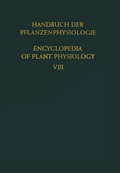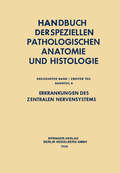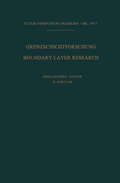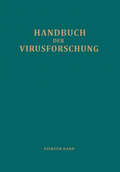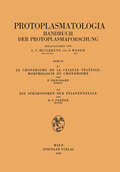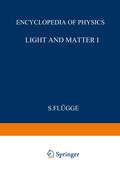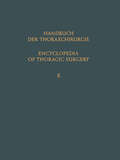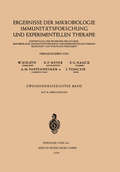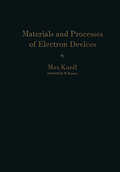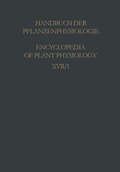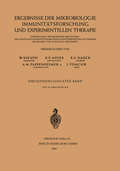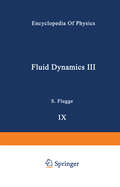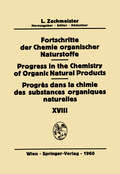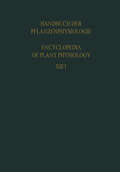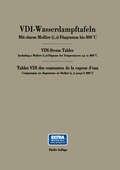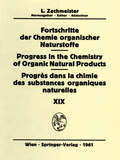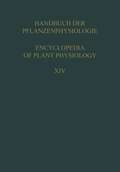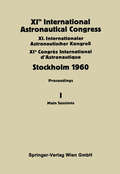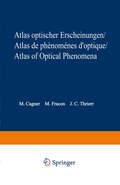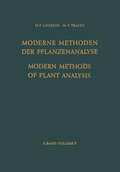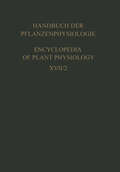- Table View
- List View
Der Stickstoffumsatz / Nitrogen Metabolism (Handbuch der Pflanzenphysiologie Encyclopedia of Plant Physiology #8)
by K. MothesErkrankungen des zentralen Nervensystems II: In 2 Teilen (pdf) (Handbuch der speziellen pathologischen Anatomie und Histologie #13 / 2)
by R. BielingGrenzschichtforschung / Boundary Layer Research: Symposium Freiburg/Br. 26.Bis 29. August 1957 / Symposium Freiburg/Br. August 26–29, 1957 (IUTAM Symposia)
by Heinrich GörtlerLe Chondriome de la Cellule Vegetale: Morphologie du Chondriome. Die Sphärosomen der Pflanzenzelle (Protoplasmatologia Cell Biology Monographs #3 / A / 1,2)
by Pierre Dangeard Ernst S. PernerLight and Matter II / Licht und Materie II (Handbuch der Physik Encyclopedia of Physics #5 / 26)
by S. FlüggeThe Metabolism of Sulfur- and Phosphorus-Containing Compounds / Der Stoffwechsel der Schwefel- und Phosphorhaltigen Verbindungen (Handbuch der Pflanzenphysiologie Encyclopedia of Plant Physiology #9)
by P. Schwarzeit became evident that the nucleoside, riboflavin, does not itself represent the original active group of the flavoprotein; it must be considered a breakdown CH a I N NH. N N H~ C "/\/ ""-C- O H3~( V " C=O 3 II I 1 - 3 H ~ " ff . . . . . . . . . . . / NH H3CJJ"N)"C/~m N?' C II II o o lumichrome lumiflavin product of a naturally occurring flavin nucleotide. Riboflavin-5'-phosphate (FMN, for flavin mononucleotide; see formula) was indicated by THEORELL as the original active group. In 1938, WARBURG and CHRISTIAN (1938 [7]-[10]) / OH ,CH CHOH- CHOH- CHOH-CH -P" 0 2- 20 N ,N OR H~A/ V " C-O 3 II I 1 - 3 H ~/"W,7'''C/NH II o Riboflavin-5'-phosphoric acid could bring excellent evidence for the idea that the co-enzyme of another flavo protein, n. amino acid oxidase, isflavin-adenine-dinucleotide or FAD (see formula). This was supported by ABRAHAM (1939), who identified both FMN and adenosine 5'-phosphate as hydrolysis products of FAD. The discovery of the coenzyme role of FAD has induced WARBURGand coworkers to engage in some speculation concerning the possibility that FMN is itself an artifact, produced through a breakdown of FAD. This aspect will be discussed later, in connection with recent work done on OYE in THEORELL'S laboratory. o NH 2 N CH3 .
Encyclopedia of Thoracic Surgery / Handbuch Der Thoraxchirurgie: Band / Volume 2: Spezieller Teil 1 / Special Part 1
by Charles P. BaileyErgebnisse der Mikrobiologie Immunitätsforschung und Experimentellen Therapie: Fortsetzung der Ergebnisse der Hygiene Bakteriologie.Immunitätsforschung und Experimentellen Therapie Zweiunddreissigster Band (pdf) (Current Topics in Microbiology and Immunology #32)
by W. Kikuth J. Tomcsik K. F. Meyer E. G. Nauck A. M. PappenheimerMaterials and Processes of Electron Devices: Werkstoffe und Verfahren zur Herstellung von Entladungsgeräten / Matériaux et procédés pour la construction d’appareils de décharges électriques / Materiales y procesos de fabricación para elementos electrónicos
by Max KnollThis bookis intended to be of assistance to the physicist or engineer concerned with designing and building electron devices such as high-vacuum transmitter- or amplifier tubes, gas- or vapor-filled rectifiers, thyratrons, X-ray or luminescent tubes, glow or incandescent lamps, Geiger- or ionization counters, vacuum photo cells, photoconductive cells, selenium-, germanium- or silicon rectifiers or trans istors. For this purpose, extensive information is required concerning the compo sition, behavior and handling of materials as well as a thorough knowledge of high-vacuum technique necessary for processing electron devices after their assembly. The text covers the preparation and working of materials used in these devices; the finishing methods for vacuum tubes (especially degassing, pumping and getter procedures); and different production steps of solid state devices. This book contains about 2300 references indicated in the text by the author's name and reference number. At the end of each chapter the references themselves are listed alphabetically by the author's name and with the title sometimes abbreviated. In accordance with the purpose of the book, "first" publications are quoted only when they contain up-to-date-knowledge of the subject in question. Patents are treated as references. The quotation of a patent gives only a hint of the technical details described there. Mentioning, or not mentioning, a patent does not imply a statement concerning its importance or validity or warning against imitation. Expired patents are named in addition to ones still valid.
Physiology of Movements / Physiologie der Bewegungen: Part 1 Movements due to Mechanical and Electrical Stimuli and to Radiations / Teil 1 Bewegungen durch Einflüsse Mechanischer und Elektrischer Natur Sowie durch Strahlungen (Handbuch der Pflanzenphysiologie Encyclopedia of Plant Physiology #17/1)
by E. BünningErgebnisse der Mikrobiologie Immunitätsforschung und Experimentellen Therapie: Fortsetzung der Ergebnisse der Hygiene Bakteriologie.Immunitätsforschung und Experimentellen Therapie (pdf) (Current Topics in Microbiology and Immunology #33)
by W. Kikuth J. Tomcsik K. F. Meyer E. G. Nauck A. M. PappenheimerFluid Dynamics / Strömungsmechanik (Handbuch der Physik Encyclopedia of Physics #3 / 9)
by C. A. TruesdellSect 2. 317 tinuity surfaces 1. This suggests that a wake pressure Pw be associated with each flow past a bluff body, and that a wake parameter (2. 4) which plays the same role as the cavitation parameter (2. 1), be defined for the flow. This idea has been made the basis of a modified wake theory (ef. Sect. 11) which proves to be in good qu- titative agreement with pressure and drag measurements. It should be emphasized, however, that un h like the cavitation number, the wake parameter is a quantity which is not known a priori, and must be empirically determined in each case. (3) Jet flows. The problem of jet efflux from an orifice is one of the oldest in hydrodynamics and the first to be treated by Fig. 3a. the HELMHOLTZ free streamline theory. Of particular importance for engineering applications is the discharge coefficient Cd' which is defined in terms of the discharge Q per unit time, the pressure P, and the cross-sectional area A of the orifice, by the formula, (2. 5) where e is the fluid density. Two methods of measuring Cd have been most fre quently adopted. In the first the liquid issues from an orifice in a large vessel under the influence of gravity _,-____________ . , (Fig. 3 a), while in the second it 1 L is forced out of a nozzle or pipe under high pressure (Fig. 3 b).
Fortschritte der Chemie organischer Naturstoffe / Progress in the Chemistry of Organic Natural Products / Progrés Dans la Chimie des Substances Organiques Naturelles (Fortschritte der Chemie organischer Naturstoffe Progress in the Chemistry of Organic Natural Products #18)
by P. W. Brian H. Brockmann J. F. Grove M. Heidelberger A. Kjaer J. Macmillan M. Pailer J. Roche N. Van Thoai O. Völker J. W. Williams L. ZechmeisterPlant Respiration Inclusive Fermentations and Acid Metabolism / Pflanzenatmung Einschliesslich Gärungen und Säurestoffwechsel: Part 1 / Teil 1 (Handbuch der Pflanzenphysiologie Encyclopedia of Plant Physiology #12)
by J. WolfVDI-Wasserdampftafeln / VDI-Steam Tables / Tables VDI des constantes de la vapeur d’eau: Mit einem Mollier (i, s)-Diagramm bis 800°C / Including a Mollier (i, s)-Diagram for Temperatures up to 800°C / Comprenant un diagramme de Mollier (i, s) jusqu’à 800°C
by Werner KochAtlas normaler Röntgenbilder des Schädels / Atlas of normal radiographs of the skull / Atlas de radiographies normales du crâne / Atlas de radiografias normales del cráneo
by W. BergerhoffFortschritte der Chemie Organischer Naturstoffe / Progress in the Chemistry of Organic Natural Products / Progrès dans la Chimie des Substances Organiques Naturelles (Fortschritte der Chemie organischer Naturstoffe Progress in the Chemistry of Organic Natural Products #19)
by D.H.R. Barton J. E. Courtois L. Crombie M. Elliot S. Ito A. Lino G. A. Morrison T. Nozoe H. H. Schlubach F. Sorm E.E. Van TamelenGrowth and Growth Substances / Wachstum und Wuchsstoffe (Handbuch der Pflanzenphysiologie Encyclopedia of Plant Physiology #14)
by H. BurströmSoziale und angewandte Psychiatrie (Psychiatrie der Gegenwart #3)
by E. K. CruickshankDer dritte Band dieses Werkes spiegelt, vielleicht mehr noch als der Grund lagenteil und die klinischen Abschnitte, entscheidende Wandlungen der Psych iatrie der Gegenwart wider: Ablösung der Psychiatrie von ihrer Ursprungsstätte, dem psychiatrischen Krankenhaus, ihr Einströmen nicht nur in fachliche Grenz gebiete, sondern ins öffentliche Bewußtsein, und die Verlagerung der praktischen psychiatrischen Tätigkeit extra muros. Manche Beiträge behandeln Stoffgebiete, die in keinem früheren Hand- oder Lehrbuch der Psychiatrie erwähnt sind und vor 20 oder 30 Jahren auch noch nicht hätten geschrieben werden können. In einer ersten Gruppe von Beiträgen zur praktischen und sozialen Psychiatrie wird diese Wandlung besonders spürbar. Es lag den Herausgebern daran, hier neuen Ansichten und Bestrebungen Raum zu gewähren, die Problematik der vielfach durch aus noch im Flusse befindlichen Konzeptionen klarzustellen, ihre Vielfalt zu gliedern und zu ordnen und die Verbindungen mit den Nachbargebieten der Psychologie, Heilpädagogik, Sozialwissenschaft, Legislatur, Strafvollzug usw. zu verfolgen. Ein einleitender Abschnitt über die neueren Strömungen in der praktischen Psychiatrie behandelt in die Zukunft weisende Auffassungen über die Organisation und die baulichen Probleme des psychiatrischen Krankenhauses und des ambulan ten psychiatrischen Dienstes. Endgültige Lösungen sind noch nicht gefunden, die Richtung der nächsten Entwicklung wird aber deutlich sichtbar. Die soziale Psychiatrie befaßt sich mit den Einflüssen der Sozialstruktur auf die Entstehung und den Verlauf seelischer Störungen, mit der Stellung des psychisch kranken Menschen innerhalb der Gesellschaft, mit der Frage seiner Hospitalisations bedürftigkeit usw. , während der seelische Gesundheitsschutz die präventiven Maßnahmen für die gesunde Bevölkerung im Auge hat.
XIth International Astronautical Congress Stockholm 1960: Proceedings Vol I: Main Sessions
by C. W. P. Reuterswärd A. HjertstrandAstrophysics V: Miscellaneous / Astrophysik V: Verschiedenes (Handbuch der Physik Encyclopedia of Physics #11 / 54)
by S. FlüggeAtlas optischer Erscheinungen / Atlas de phénomènes d’optique / Atlas of optical phenomena
by Michel Cagnet M. Francon J.C. ThrierrModern Methods of Plant Analysis / Moderne Methoden der Pflanzenanalyse (Modern Methods of Plant Analysis Moderne Methoden der Pflanzenanalyse #5)
by K. Biemann N. K. Boardman B. Breyer S. P. Burg W. L. Butler D. J. David P. S. Davis A. E. Dimond A. C. Hildebrandt F. A. Hommes O. Kratky H. F. Linskens H. Moor K. H. Norris I. J. O'Donnell J. V. Possingham H. Prat D. H. Slogteren E. Stahl J. A. Veken J. P. Want E. F. Woods123 phase and hence have no direct bearing on the retention time of solutes. However in gas-solid chromatography, a considerable quantity of the mobile phase may be adsorbed on the surface of the stationary adsorbent which diminishes the column's effective length and ability to retain solutes. In this respect helium has been found to be preferable to most other gases (GREENE and Roy, 1957) because it is adsorbed to the least extent. 3. Packed columns offer a considerable resistance to flow, which may create a pressure differential between inlet and outlet of sufficient magnitude to cause an unfavorable flow rate through a significant length of the column. A reduced inlet/outlet pressure ratio can be obtained by using light molecular weight gases toward which the column packing shows the greatest permeability. The flow rate of the mobile phase is normally adjusted by altering the column inlet pressure, for which purpose commercial pressure regulators of sufficient accuracy are available. Quantitative measurements of the flow rate can be made by a number of methods, including rotameters, orifice meters, soapfilm flow meters and displacement of water. The former two methods are the most con venient but the least accurate; moreover they create a back pressure and are temperature dependent whereas although the moving soap bubble is cumbersome to employ and unusable for continuous readings, it is preferred when the highest accuracy is required.
